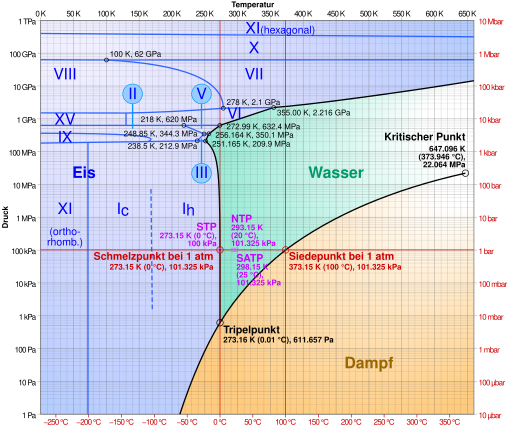Pressure melting
Under pressure melting point is meant the effect that the melting point of ice by increasing the pressure may decrease. In the Glaciology the superposed by the contact pressure masses reduced melting temperature of ice pressure melting point , called a for tempered glacial significant mechanism, even with the most mountain glaciers due to pressure reduction of the melt temperature is only slightly (<1 K ).
For each additional bar of increased pressure, the melting point drops linearly by approx. 0.0077 K, i.e. by 0.1 K for an ice thickness of approx. 120 m, which, however, only applies to low pressures. At high pressures (> 500 bar, i.e. approx. 5500 m), the decrease in the melting point accelerates non-linearly, since the density of water at the freezing point increases almost linearly with increasing pressure, but the density of ice at the freezing point increases more slowly with increasing pressure, until it becomes constant above about 150 MPa (1500 bar).
The relationship follows somewhat more precisely from the Clausius-Clapeyron equation
Here are:
- The new melting point
- The old melting point at the initial pressure.
- The change in pressure
- The specific volumes of the substance (L ... liquid, S ... solid).
- The specific heat of fusion of the substance.
The inaccurate view is very widespread that this effect during ice skating melts the ice solely through the pressure of the blades and creates a film of water that enables the blades to slide. In fact, however, the movement of the runners also causes frictional heat, which melts the ice and forms a lubricious film of water.
The following billing process demonstrates the dimensions:
- For a high-speed ice skate with - as usual - a rectangular flat-ground blade, a thickness of 1.5 mm (= 0.15 cm) and a length of 40 cm are assumed. The total area is therefore 40 cm × 0.15 cm = 6 cm². It should be noted, however, that the runners have a hollow profile across the sliding direction. Only the two razor-sharp edges of a runner are in contact with the medium "ice".
- A speed skater with a mass of 75 kg exerts a weight of 75 kg * 9.81 m / s² = 736 N.
-
Flat runner: Spread over 6 cm², this corresponds to a pressure of 736 N / 6 cm² = 123 N / cm² = 12.3 bar, if
- the ice surface is absolutely flat and the flat runner rests with its entire surface on the ice surface. In reality, however, this is rarely the case.
- This would lower the melting point by 12.3 × 0.0077 K, i.e. only 0.09 K.
- Hollow ground runner : Distributed over the edges of the hollow ground runner with a contact surface of only 1/100 of the rectangular area above, a pressure of 1230 bar is generated. A pressure of 1230 bar would shift the melting point to approx. -10 ° C. Therefore, the ice temperature of artificial ice rinks is between -12 ° C and -7 ° C.
-
Flat runner: Spread over 6 cm², this corresponds to a pressure of 736 N / 6 cm² = 123 N / cm² = 12.3 bar, if
Theoretically, even at −1 ° C, ice skating with a rectangular, flat runner would not be possible if only the pressure melting were used as an explanation. The pressure melting can therefore not only be used for the mechanism of ice skating. It should also be remembered that all other sliding tools (skis, sledges, etc.) have even larger surfaces and exert even less pressure. In addition, below approx. −22 ° C ( triple point of water, ice I h and ice III), ice skating or skiing is more difficult (more handy) because below this temperature there is no longer any liquid water.
As a reminder, the physical unit dimensions:
- 1 Newton (unit) = 1 kg · m / s²
- a mass of 1 kg exerts a weight of 9.81 kg · m / s² ≈ 10 Newtons on earth at sea level.
- 10 N / cm² = 1 bar
Individual evidence
- ↑ Martin Chaplin ( London South Bank University ): Explanation of the Density Anomalies of Water: D2 Water expands on freezing , accessed December 28, 2018
- ↑ Jürgen Vollmer, Ulrich Vetter: Ice skating: Why is ice so smooth? In: Welt der Physik, February 22, 2008, accessed December 28, 2018.
- ↑ Patrick Kharadi: The figure skating cut. Accessed February 2, 2019 (German).






